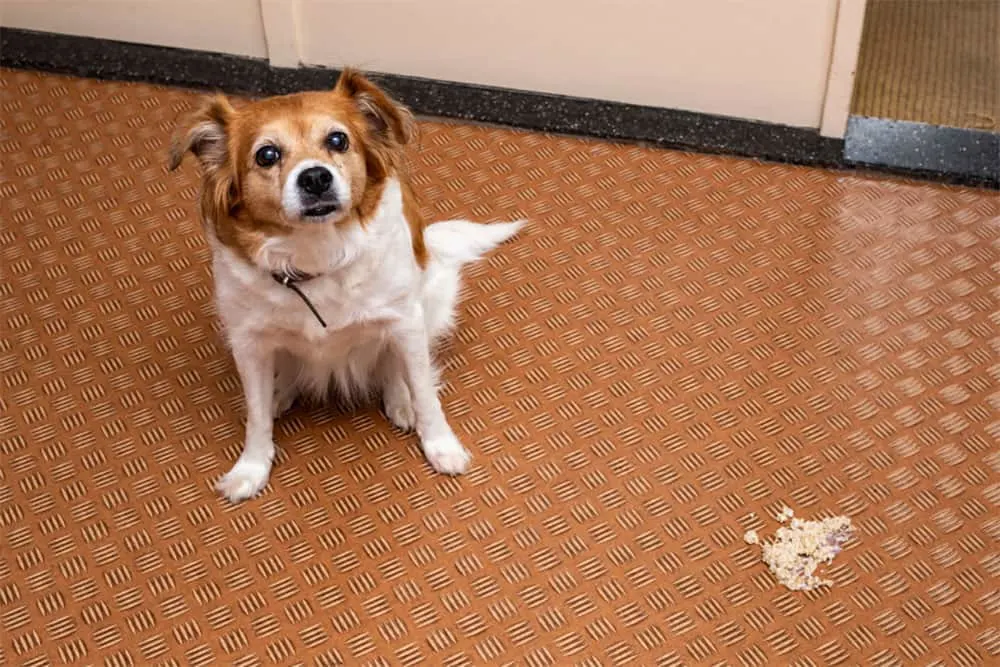The Ultimate Dog Vomit Color Guide — Should You Be Worried?
When you come home from work and see a pile of vomit on the floor, you might get worried.
However, it is not necessarily a cause for concern. Your dog might’ve simply eaten something bad while you weren’t looking.
That said, don’t disregard this symptom too fast. Vomit can also be a warning sign of underlying health issues.
How to tell if you should do anything about it?
More often than not, vomit’s color or consistency can help you determine if it’s anything serious.
We have put together a handy guide for dog owners to check whether your pet needs medical attention.
Let’s jump right into it.
Has Your Dog Actually Vomited?
We often refer to vomit as any kind of liquid that your dog expels, but this isn’t strictly true.
- Vomiting is the expulsion of food that has reached the stomach.
- Regurgitation is when food still in the esophagus comes back up before it reaches the stomach and begins to be digested.
Your dog may regurgitate if they ate or drank too quickly or exercised too soon after eating. The process of regurgitation is different from vomiting, as there will be no prolonged retching.
Your dog may also cough up phlegm that you could confuse for vomit, especially if they have been coughing several times throughout the day.
Vomiting is often accompanied by nausea.
To confirm your suspicions, look out for signs that your dog is feeling nauseous. They might be drooling more than usual or be uninterested in their food.
Your dog might also be lethargic, showing little enthusiasm for the toys and activities that usually make them happy.
What Causes Vomiting in Dogs?
There could be many reasons why your dog is vomiting. Here are some of the most common causes.
- A change in food or diet: Different types and brands of dog food contain different ingredients. Some foods are richer than others, and a change in food can cause a temporary upset to your dog’s digestive system.
- Eating things they shouldn’t: If your dog gets into the trash or steals food from the counter, it can give them an upset stomach.
- Eating something toxic: Some foods, plants, and medications are toxic to dogs. If you think your dog has ingested something toxic, they need immediate medical attention.
- Bacterial infection: Just like us, dogs can pick up stomach bugs and bacterial infections, which may cause them to vomit.
- Intestinal parasites: When exposed to different animals or rotten meat whilst on a walk, dogs can pick up parasites. It might cause vomiting.
- Foreign body in gut: If your dog has swallowed a toy or a piece of clothing, it might be blocking their digestive tract. It will prevent the food from traveling through, causing your furry friend to vomit it back up.
- Serious medical issues: Pancreatitis, kidney disease, liver disease, diabetes, and cancer are all severe medical conditions that can cause vomiting.
- Motion sickness: Dogs can get travel sick, just like us. Your dog might be sick after or during a car journey.
- Food allergies or intolerance: Dietary requirements vary from dog to dog. Some dogs are intolerant or allergic to certain foods, which can cause vomiting.
Types of Dog Vomit

There are many things you can learn about the vomit from the texture alone, even without considering the color.
| Type of Vomit | What It Means |
|---|---|
| Chunky Vomit | Chunky dog vomit is usually a sign your dog has eaten something they shouldn’t have. The other possible cause is that their digestive tract is blocked. |
| Liquid Vomit | If the vomit has no chunks and is a pale liquid, it means your dog has an empty stomach. In most cases, liquid dog vomit is bile — a yellow substance produced in the liver that aids digestion. When your dog is throwing up bile, it could be a case of bilious vomiting syndrome or another health issue like a food allergy or pancreatitis. |
| Slimy Vomit | Slimy vomit can be due to the dog salivating excessively. It’s a common symptom of nausea, which can indicate several other issues. It’s best to contact your veterinarian if you don’t know why your dog might be nauseous. |
| Foamy Vomit | The presence of white foam in the vomit indicates the contents of the stomach were sloshed around before being expelled or that the stomach was empty. It is also a possible sign of pancreatitis, which needs to be taken seriously. |
Dog Vomit Color Guide and What Each Color Means
If you want to learn what different colored vomit means, refer to the dog vomit color chart below. It lists all the possible options, along with explanations for each color.
| Your Dog’s Vomit Color | What It Means |
|---|---|
| Brown Dog Vomit | Brown vomit can be caused by brown food like meat or biscuits. It can also be caused by eating feces — an unpleasant habit that is not uncommon among dogs. On rare occasions, brown streaks in the vomit can be traces of old blood. It may indicate internal bleeding, which needs medical attention. |
| Red Dog Vomit | Some dog biscuits and treats contain red food dye, which can change the color of your dog’s vomit. Unfortunately, red color can also be a sign of blood in the vomit. Bright red vomit is often a symptom of stomach irritation, ulcers, or other gastrointestinal issues that irritate the digestive tract and require urgent medical attention. |
| Yellow Dog Vomit | Yellow is the most common color for dog vomit. Still, it isn’t something you should ignore. Yellow vomit is usually bile. It suggests your dog vomits on an empty stomach. When dogs vomit liquid, it points to the fact that they are nauseous even with no food to throw up. It’s best to contact your vet if your dog continues to vomit on an empty stomach. |
| Orange Dog Vomit | While bile is usually a yellow liquid, it can also look more like orange. Therefore, orange vomit may be a sign your dog’s stomach is empty. Yet, it’s not the only explanation. Sometimes, when your dog vomits an orange substance, it will be linked to their diet. There could be a particular type of food or ingredient causing this strange color in their vomit. Another potential cause is that the vomit is orange due to the presence of blood. It happens when blood mixes with a yellow substance like bile. Connect with a professional in veterinary healthcare to receive advice tailored for your furry friend. |
| Black Dog Vomit | When you find your dog throwing up black vomit or coffee ground like material in their vomit, it’s easy to get scared. Eating soil or dirt can cause the vomit to appear very dark, but black vomit could also be digested blood. Closely examine the color and texture of the vomit. If your dog has blood in their GI tract, take them to the vet immediately. |
| Green Dog Vomit | If your dog has been eating grass, it can make your dog’s vomit appear to be bright green. Bright green vomit can also mean that bile is present and the stomach is empty. |
| White Dog Vomit | White dog vomit is usually harmless. It can form when a dog’s vomit comes in contact with air or is sloshed in the stomach before being expelled. |
| Grey Dog Vomit | This color can be a sign of prolonged gastrointestinal upset, bile, or, in worst cases, liver failure. You should take your dog to the vet. |
Conclusion
Many dog owners get worried when their beloved pet starts vomiting. Yet, it doesn’t have to be anything serious.
Our vomit color guide can help you establish if your dog requires medical assistance.
We have created this dog vomit color guide to give you a reliable source to refer to when your dog has a vomiting episode.
Still, if you’re unsure, it is always best to play it safe and seek veterinary advice. They will help you determine if your pup’s vomit can indicate more serious problems.
Frequently Asked Questions
What are some common causes of vomiting in dogs?
Common causes of vomiting in dogs include:
– a change in food or diet
– eating things they shouldn’t (such as trash or greasy foods)
– eating something toxic
– bacterial infection
– intestinal parasites
– foreign body in the gut
– serious medical issues (such as pancreatitis or kidney disease)
– motion sickness
– food allergies or intolerance
What does it mean if your dog has white foam in their vomit?
The presence of white foam in the vomit indicates the contents of the stomach were sloshed around before being expelled or that the stomach was empty. It is also a possible sign of pancreatitis, which needs to be taken seriously.
What color should dog vomit be?
The color of a dog’s vomit may vary depending on the cause.
In general, a dog’s vomit should be a yellowish or light brown color. However, if the vomit is consistently a different color or contains blood, it may be a sign of a health issue and requires veterinary attention.
What are the types of dog vomit?
Various types of dog vomit indicate different things. It could be foam-like vomit, food chunks, partially digested food, bile, or even blood. The type of vomit can provide essential clues about the cause of vomiting.
What should I do if my dog vomits a lot?
If your dog is vomiting frequently or showing other concerning symptoms, it’s important to consult with a veterinarian. Excessive vomiting can lead to dehydration and other complications, so it’s best to seek professional advice.
Why is my dog vomiting clear liquid?
Vomiting clear liquid, often referred to as foamy vomit, can be caused by various factors such as excessive drinking, eating too fast, or an upset stomach. However, if the clear liquid vomiting persists or is accompanied by other symptoms, it’s recommended to consult with a veterinarian.
Can the color of the vomit tell me what my dog ate?
The color of your dog’s vomit may give you some indication of what they ate. For example, if your dog vomits yellow or greenish bile, it may suggest that they haven’t eaten for a while.
However, it’s important to note that the color alone may not provide a definitive answer.
What should I do if my dog vomits after eating?
If your dog vomits after eating, it could be due to various reasons, such as an upset stomach, food allergies, or eating too fast. Try feeding smaller meals or changing their diet to see if it resolves the issue. If the vomiting persists or worsens, consult with a veterinarian.




















